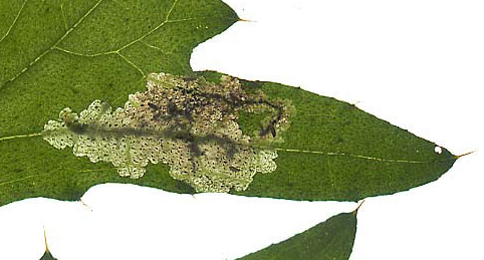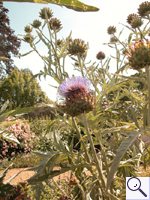|
||||||
|
CYNARA. Globe Artichoke. [Asteraceae] |
|
|
Globe Artichoke (C. cardunculus), which is introduced and cultivated, is the only species of Cynara recorded in Britain. Six British miners are recorded on Cynara. A key to the European miners recorded on Cynara is provided in Bladmineerders van Europa. |
|
Key for the identification of the known mines of British |
1a > Leaf-miner: A distinctive mine primarily above mid-rib, with irregular short lateral offshoots into leaf blade. Pupation external (Spencer, 1972: 51 (fig. 172), 55; Spencer, 1976: 270, 271 (fig. 486)). Branched, whitish, upper-surface corridor; main axis overlying the midrib; side branches overlying the main lateral veins. (In Campanula and Phyteuma the mine is much less branched, sometimes nothing more than a corridor on top of the midrib). Frass in rather long strings. Usually the mines begins as a long and narrow, shallow, tortuous lower-surface corridor that ends upon the midrib but otherwise is not associated with the leaf venation. Often this initial corridor is filled with callus, and then even less conspicuous. Pupation outside the mine. A linear mine on the upper surface, usually following the midrib and showing side branches along the veins. The frass is in strings. |
|
Liriomyza strigata (Meigen, 1830) [Diptera: Agromyzidae]. |
1b > Leaf-miner: Large, very transparent blotch, with primary and secundary feeding lines. In the centre a concentration of black frass. Mines can coalesce, and then contain several larvae. At the start of the mine, at the leaf underside, a white egg shell. However, the larva can leave its mine and restart elsewehere, therefore mines without an egg shell may occur as well. A white egg is laid at the start of the mine, on the leaf underside. A large clear mine is formed in the centre of the leaf, with a black frass pile. Mines may coalesce and so a mine may contain several larvae (British Leafminers). |
 Mine of Pegomya steini on Cirsium vulgare Image: © Willem Ellis (Bladmineerders van Europa) |
|
Pegomya steini Hendel, 1925 [Diptera: Anthomyiidae]. |
1c > Leaf-miner: Mine linear, whitish, both upper and lower surface. Pupation internal, at the end of the mine with the anterior spiracles projecting through the epidermis (Spencer, 1976: 433). Upper-surface, less often lower-surface corridor. Frass in isolated grains. Pupation within the mine, usually in a lower-surface puparial chamber. A long whitish upper surface corridor, which eventually goes lower surface. |
|
Chromatomyia
horticola (Goureau, 1851) [Diptera: Agromyzidae] |
1d > Leaf-miner: The eggs of this species are laid on a leaf, with the larvae mining the underside of the leaf, until a late instar when it feeds in a web under the midrib of the leaf, causing visible blotching on the upperside. Short, full depth corridor. The larva relatively long lives as a miner, but finally leaves the mine and continues living in spinning along the midrib at the leaf underside, from where windows are eaten in the leaf. |
 Mines of Agonopterix propinquella on Cirsium arvense Image: © Ian Smith (UKMoths) |
|
Agonopterix propinquella (Treitschke, 1835) [Lepidoptera: Depressariidae]. |
1e > Long corridor, often following the leaf margin, with little frass and with the sides irrregularly eaten out. The first part of the corridor is full depth and makes a few close loops; the later part is more upper-surface and rather wide. Primary feeding lines often conspicuous. No morphological differences are known between the larva of S. rubidum and S. testaceum (Steinhausen, 1994a). However, there is a phenological difference: the larva of testaceum hibernates in the mine and continues feeding after winter; S. rubidum vacates the mine before winter and pupates in the soil. Hering (1957a) suggests that the identification of the beetles is an easy matter, but that is contradicted by Warchalowski (2003a). |
|
Sphaeroderma testaceum (Fabricius, 1775) [Coloeptera : Chrysomelidae] |
1f > Long corridor mine, without obvious relation with the leaf margin, with little frass and irregularly eaten out sides. The first part of the mine is full depth and makes a few close loops; the second part is upper-surface and considerably wider. Primary feedings lines often obvious. The larva is so broad that is completely fills the mine. No morphological differences are known between the larvae of S. rubidum and those of S. testaceum (Steinhausen, 1994a). The larva leaves the mine to pupate in the soil (the larva of testaceum hibernates in the mine.) Hering (1957a) suggests that the imagines are easily separated, but this is contradicted by Warchalowski (2003a). |
|
Sphaeroderma rubidum (Graells, 1858) [Coloeptera : Chrysomelidae] |
| Last updated 03-Jul-2019 Brian Pitkin | ||

